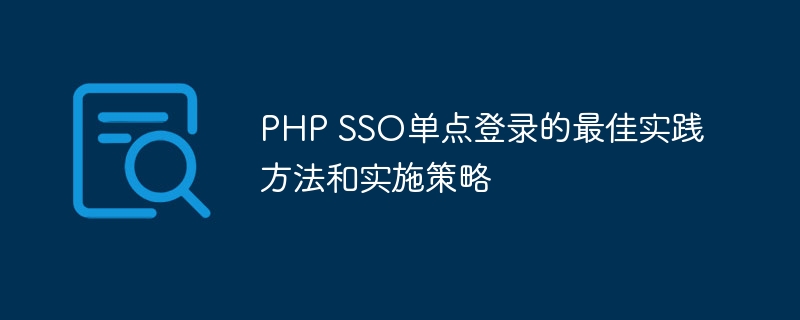

PHP SSO single sign-on best practices and implementation strategies require specific code examples
Single Sign-On (SSO) refers to An authentication mechanism in which users only need to log in once to access multiple independent application systems without having to authenticate again. For users within enterprises or multiple application systems, SSO can improve operational efficiency and user experience, and reduce the trouble of repeated logins. In this article, we will introduce the best practices and implementation strategies of SSO in PHP, and provide specific code examples to help readers better understand its principles and implementation.
1. Implementation methods
There are many ways to implement SSO. Common methods include Cookie-based, Token-based and OAuth2.0-based. This article will introduce the implementation method of SSO in PHP based on Token.
2. Token generation and verification
1. Generate Token
After the user successfully logs in, we need to generate a Token and store it in the database or cache. Token can be a random string or a regular string, such as an encrypted string based on user ID and timestamp.
function generateToken($userId) {
$key = 'your-secret-key'; // 密钥
$timestamp = time(); // 当前时间戳
$token = md5($userId . $timestamp . $key); // 生成Token
// 存储Token到数据库或缓存
// ...
return $token;
}2. Verification of Token
When users access other application systems, the validity of the Token needs to be verified. Validation can be done through the database or cache.
function validateToken($token) {
// 从数据库或缓存中获取Token
// ...
if ($token == $storedToken) { // Token有效
return true;
} else { // Token无效
return false;
}
}3. Implementation strategies
1. Shared login status
In SSO, users only need to log in once to access multiple application systems. Therefore, different application systems need to share login status. Sharing of login status can be achieved through a shared database or cache.
// 用户登录
function login($userId) {
$token = generateToken($userId); // 生成Token
// 存储Token到数据库或缓存
// ...
setcookie('token', $token, time() + 86400, '/', '.example.com'); // 设置Cookie
}
// 用户访问应用系统A
function accessSystemA() {
$token = $_COOKIE['token']; // 获取Cookie中的Token
if (validateToken($token)) { // 校验Token
// 用户已登录
// ...
} else { // Token无效
// 跳转到登录页面
// ...
}
}
// 用户访问应用系统B
function accessSystemB() {
$token = $_COOKIE['token'];
if (validateToken($token)) {
// 用户已登录
// ...
} else {
// 跳转到登录页面
// ...
}
}2. Security considerations
When implementing SSO, security is very important. We need to ensure the security of Token to prevent it from being stolen or forged. Security can be improved through the following methods:
4. Summary
This article introduces the best practices and implementation strategies of SSO single sign-on in PHP, and provides specific code examples to help readers better understand its implementation principles. . By using a token-based approach, we can achieve single login across multiple application systems, improving user experience and operational efficiency. When implementing SSO, security needs to be considered and measures taken to prevent token leakage and forgery. I hope this article will help readers understand how to implement SSO in PHP.
The above is the detailed content of Best practices and implementation strategies for PHP SSO single sign-on. For more information, please follow other related articles on the PHP Chinese website!




